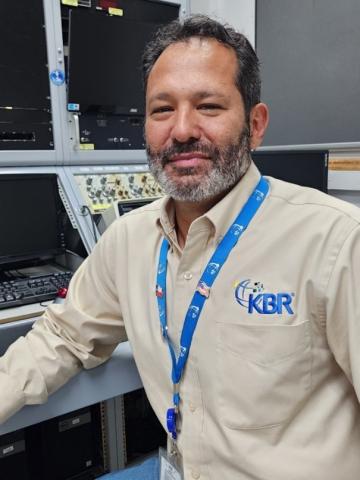Before They Fly, They Train: Amazon Prime and IMAX Blue Angels Documentary Features KBR Aerospace Environment Protection Laboratory
KBR has supported fast-jet training for heroes like the Blue Angels at Brooks Air Force Base for more than 50 years and, in 2011, became solely responsible for the operation of the Aerospace Environment Protection Laboratory (AEPL) in San Antonio, Texas. The unique facility hosts a human-rated centrifuge where pilots and astronauts come to train annually, including the U.S. Navy’s elite aerial exhibition team.
The new documentary “The Blue Angels” showing in IMAX theaters across the nation and streaming on Amazon Prime, takes viewers behind the scenes with the prestigious flight squadron. It follows the selection process of the 2023 Blue Angels team – including the first female Blue Angel – and chronicles their journey through grueling training, including a visit to KBR's AEPL in September 2022.
KBR provides all personnel, resources, facilities and maintenance for centrifuge-based flight environment training and conducts all required inspections to ensure safe operations. KBR instructors teach students about the physiological effects of acceleration and countermeasures used in a high-G environment. During their training, astronaut and flight crew students receive classroom instruction and hands-on experience in the centrifuge.
The AEPL segment, which lasts around 10 minutes, is showcased toward the end of the film and highlights the tremendous effort involved in the training process, led by KBR’s Gabe Gonzalez, Acceleration Program Lead.
“It’s an honor and a privilege to host the Blues every year. You won’t find a more motivated and professional team anywhere,” Gonzalez said.
Described by Hollywood Reporter as a “harrowing sequence,” the audience gets an up-close look at the Blue Angel trainees passing out during a centrifuge testing session. When experiencing a rapid upward acceleration, the body’s blood flow struggles to keep the brain supplied with enough oxygen, which can lead to G-LOC or G-induced loss of consciousness. G-LOC is a major danger for pilots and can take up to 30 seconds for an individual to recover their situational awareness – often more than enough time to crash while flying at such high speeds.
Situations like these can be seen in the latest Top Gun Maverick movie when Lt. Javy “Coyote” Machado begins to go down during a training run but regains control of the aircraft at the last second to avoid a collision with the mountains.
“G-LOC is a constant threat to aircrew in fighter aviation. In a turning fight in an F-18, the pilot is trying to solve a three-dimensional, real-time, dynamic geometry problem in his head while an elephant sits on his chest and he’s squeezing every muscle in his lower body as hard as possible. Failure means loss of consciousness at a time when even the smallest mistake is fatal,” Gonzalez added.
To counteract this threat to safety, pilots typically wear compression G-suits to help them stay conscious. Like a blood pressure cuff, G-suits work by inflating to create pressure in the lower extremities to reduce blood pooling and assist blood flow to the brain.
However, Blue Angel pilots cannot wear G-suits while flying because their inflating and deflating could interfere with the plane’s controls. Therefore, pilots are trained to manage the G-forces with sheer physical strength, a key reason they are required to stay in good physical condition and peak health.
KBR experts are trusted to train these pilots on how to combat G-LOC with the Anti-G Straining Maneuver (AGSM). AGSM involves tensing muscles in the legs, abdomen and buttocks to force blood back toward the heart and brain, giving them a self-inflicted squeeze to maintain consciousness.
“Success is not a given,” Gonzalez explained. “Not every student naval aviator who comes through our doors completes the training. It takes an enormous amount of skill and discipline to thrive in the high-G environment.”
In the end, all three pilots passed the centrifuge training to move on to the next step of becoming Blue Angels. On March 11, 2023, the Blue Angels made history again when Lieutenant Commander Amanda Lee flew her first official air show at the Naval Air Base El Centro.
Beyond human centrifuge training, the KBR AEPL team in San Antonio boasts a wide range of expertise and equipment. This includes altitude chamber training, which simulates high-altitude conditions for air and space crew familiarization and physiological training. The team's technical focus lies at the intersection of human physiology and extreme environments. Their expertise encompasses aerospace physiology and human performance, investigating human adaptation and limitations within the harsh realities of aviation and space. They delve into aeromedical evacuation procedures and technology, optimizing methods and equipment for safe patient transport by air. Additionally, their focus on life support systems ensures the reliability and performance of critical equipment, such as oxygen systems, for crew survival in these demanding conditions.
KBR’s Gabe Gonzalez, Acceleration Program Lead




